#fantasy language
Text
Sometimes I randomly remember that Kaz is the only member of the Crows who only speaks one language and for no apparent reason I find that endlessly amusing.
Like, the comedic potential here? Nina and Inej girl talking but as soon as he walks in the room they switch to Ravkan?? Wylan and Nina chatting in Kerch but then switching to Fjerdan when Matthias walks in and suddenly Kaz has completely lost track of the conversation?? Jesper saying something to Kaz in Zemeni that makes Nina howl with laughter, but neither of them will tell him what it was??? It’s so funny to me.
He would also absolutely start learning another language out of sheer spite if they did this, but I think it would be hilarious if he chose Kaelish and tried to use it with Jesper and Jesper would just be like “… I don’t speak Kaelish. I just know a little bit… I can sing in Kaelish, if you want?” and Kaz is so disappointed by this but he can’t show it so he just starts yelling at Nina in Kaelish instead. She corrects his pronunciation and he nearly murders her.
Everyone’s having fun.
#grishaverse#leigh bardugo#six of crows#crooked kingdom#jesper fahey#kaz brekker#nina zenik#wylan van eck#inej ghafa#kanej#Ravkan#kerch#ketterdam#languages#fantasy language#fantasy books
8K notes
·
View notes
Text
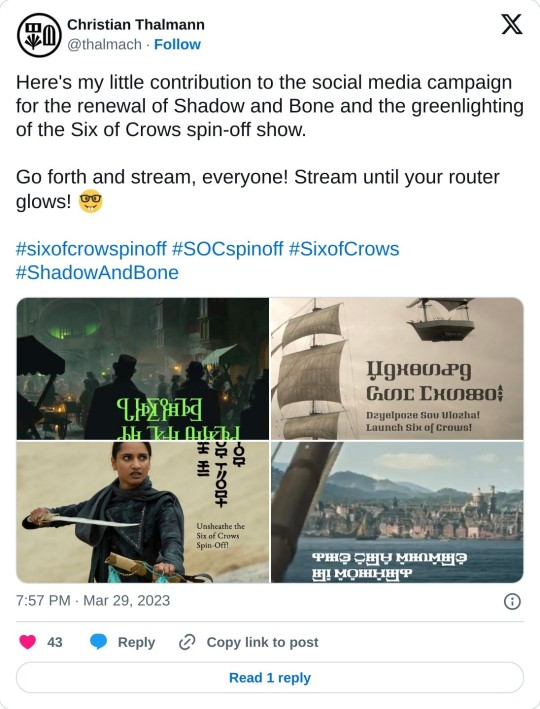
Posts made by one of the conlangers of the show - Christian Thalmann! It's amazing to see the languages of the Grishaverse used to help us fight!
#grishaverse#shadow and bone#six of crows#netflix#netflix shadow and bone#soc and ck#sab#kazzle dazzle#six of crows fandom#soc#conlang#fantasy language#language#the grisha series#no mourners no funerals#saveshadowandbone#save shadow and bone#sixofcrowsspinoff#six of crows spinoff#kaz dirtyhands brekker#kaz brekker#sankta inej#soc inej#inej gafha#jesper fahey#alina starkov#wylan van eck#nina zenik#matthias helvar#mal oretsev
257 notes
·
View notes
Text
PANDORIAN LANGUAGE II.
SSO - Pandorian alphabet, writing and examples
(Unofficial / fanmade)
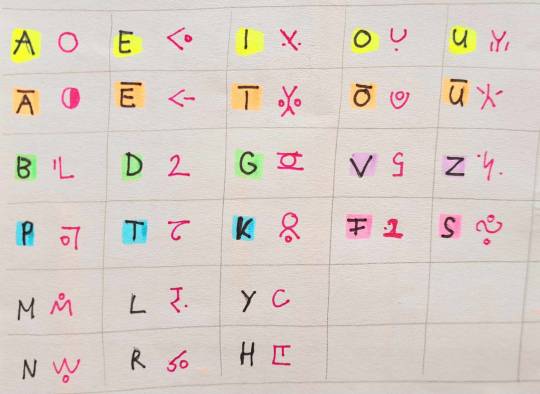

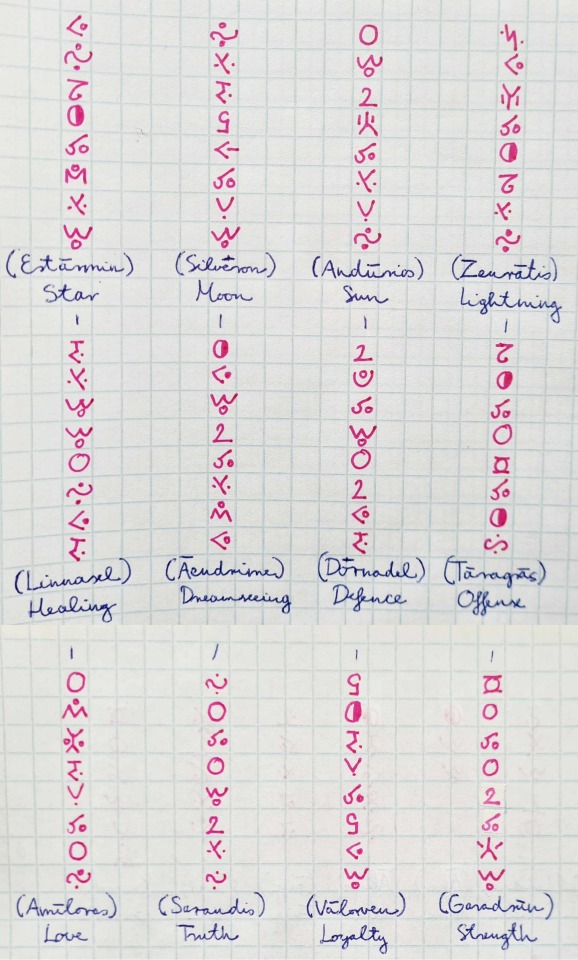

This is fanmade. Not made by the sso tean, sadly they would never put energy into something fun like this. The runes used in the game aren't spelling out anything, they were not put in with a language in mind.
This would be the new pandorian alphabet, and storywise MC would recarve the runestones for them to do actual magic.
For a more detailed description and story see my previous post on pandorian language.
#sso#star stable online#star stable#sso magic#sso pandoria#sso runes#starstableonline#ssoblr#sso rewritten#sso full story series#fantasy language#conlang
199 notes
·
View notes
Text
The Common Language(TM)
Saw a post trying to explain how Common (a... common language) exists in fantasy settings and (I assume) DnD. I personally disagreed with OP's interpretations as they funneled explanations into two camps:
-Humans are so imperialist they made everyone else speak it (a travesty to act like humans are the center of the universe again)
-All languages form Common out of trade necessity, BUT the words contributed retreat into fantasy stereotypes (orcs are warriors, elves are artisan waifs, etc.). Which, IDK guys, at best it comes across as over-explaining US English with extra steps and baggage.
Now personally, I treat languages in my own campaign as mostly geological*- because I'm running a campaign, not writing a book/wiki/conlang.
*A few languages are bound to their speakers simply because they don't have humanoid mouths, eg: Primordial is spoken by Elementals, AKA sentient elements, etc.
Naturally, this led to wondering how the existence of Common could be a larger feature that could be interacted with. While conlangs can be fun, they are often treated as fossils when players probably prefer to walk among dinosaurs.
Note: This is written through the lens of DnD/a fantasy TTRPG, but it could probably function elsewhere with mindful tweaks., build according to your preferences.
In this scenario, all cultural languages exist, but a reverse tower of babel situation occurred. So now the world has a large magical tower that gifts all sentient humanoids (PCs/NPCs) with Common.
For World Flavor:
The immediate obvious possibility is that several nations/peoples agreed to collaborate on this, it's up to you if any individuals are named. But since it was so long ago, that might be lost to time. Or maybe it was recently completed! Regardless, is the tower a Wonder that is communally protected or does this responsibility fall on a certain group?
Or is the Tower Divine? A gift from a god of language, a god of peace or something else entirely (a god of venom who wanted to afford all mortals the ability to hurt each other with words, etc.)? If it is divine, what is the story that explains it? Is there a faith that worships the Tower (and its god)? How do people who may dislike this god reconcile the benefits of the Tower with their distaste for the deity?
Or is it an (inter)national archaeological mystery that is currently being studied? What has been hindering progress? Is it people (who has right over this) or something more otherworldly (supernatural defenses)?
Or maybe it really is just a funny little quirk of the world- a team of wizards bestowed the world with a lingua franca for an easier conference since they don't have time to learn other languages, back to other stuff!
For Conflicts/Hooks:
Is it housed in the current world's seat of power (or was a superpower built around it)? Is this fact used as a Divine Right to be an Authority over others?
Are new words added? Does this affect magic with Verbal Components? Is this how the world's spells are created? Are expeditions sent into the Tower to attempt to add more spells? Have magical words (spells) been lost (or removed)? Does this mean the Tower is ALSO the world's seat of magic?
Can Mundane words be lost? Does this somehow erase *all* instances of this written word? Or does it remove their inherent meaning and Essence (eg: if the word Sweet was lost, would all things cease to be sweet or would sweetness slowly bleed out of the world as sweet and its synonyms are eroded? How would the remaining languages try to preserve this concept in reaction to the Tower?
Was this word loss an accident or intentional?
Is this aspect abused? Is/has it been used as a political weapon/threat? How does exterior damage to the tower, if it can suffer any, affect the language it actively imbues in people? Or does it merely impact how effective its power is?
Or is the Tower decaying and there is a lingual epidemic where communication is collapsing in places that have become overly reliant on the Common provided by the Tower? What do attempts to fix the Tower look like? If the Tower is Divine in origin, how do the pious interpret this development (a test, malice from another god, etc)?
Is a lack of Common in a person used as a pretense to do harm to them? Is it used as 'evidence' to strip them of rights/dignit? Or is speaking Common a litmus for adulthood (eg: babies babble, adults converse, etc.)? How does this belief affect Mute or Deaf people?
Are there people that believe in the superiority of a Cultural Language (since they equate effort to value and Common requires 'no effort')? Are there people that consider Common to be a mark of a lack of intelligence?
Is there an effective range to the Tower? Is there a material or other phenomena that interferes with the Tower's effect on people? How would the PCs react to suddenly being unable to speak Common within their own party for a scenario?
How would anyone react if mundane livestock suddenly spoke? What if fields of plants started screaming?
Would anyone seek a way to sever the tower's influence from themselves (or others)? If the Tower can magically/divinely influence people with the ability to use Common, what else can it do? Would someone ever seek to alter this aspect of the Tower? Could they use it to continuously, universally emit healing? What about silence? (Is the Tower simply automatically converting all words to Common, effectively robbing all the intricacies of natural cultural languages?)
Would there be a reason to destroy this tower? Who would benefit from it (culturally/politically/etc.)? How would the world be changed if it was suddenly destroyed? Who would attempt to fix it? Could it even be fixed?
For Mechanics:
Some challenge uses have already been suggested above with Common Language and/or Verbal Magic dead zones.
But more cut and dry mechanics could tie to how Silence, Comprehend Languages and other linguistically-tied spells tap into/invoke the Tower and even require a nonstandard component.
Additionally, maybe this is where the Power Words (Kill, Heal, Stun, etc.) originated from and can only be found there- and what if there are more?
If you wanted to get cheeky you could probably attribute other word/language spells (Healing Word, etc.) to the Tower, but every table is different.
Hopefully this inspires some fun at the table. Or if you're already running a campaign, you can downsize this effect to a dungeon/wizard's tower/town.
This idea is of course free for use, and if you do use it, please share your story of how it played out! Have fun o/
#dnd#d&d#dungeons and dragons#fantasy writing#fantasy language#fantasy worldbuilding#dungeon master ideas#long post#blankd rambles
239 notes
·
View notes
Text
decided that having any kind of 'common language' was too convenient for my characters. yall thought you could just talk to anyone? with no barriers or misunderstandings? nay. oh and also you're in an area that's known for its wide variety of intelligent species and cultures. good luck!
#though its also. inconvenient for me lol#i gotta keep track of what languages every important character can speak and/or understand#fantasy#fantasy oc#fantasy writing#worldbuilding#fantasy worldbuilding#creative writing#fiction#fantasy language#writing#writeblr
24 notes
·
View notes
Text

the names of each species written in their most common language
All species have hundreds if not thousands of languages spoken by countless groups, however there are dominant languages spoken by most as at least a second language.
Olorans are the closest to only having one language as its phisically impossible for them to make a variety of sounds, meaning kukuma has basically become their species only spoken language.
Humans had dozens of dominant languages over the centuries of space travel. However the current longest existing one is Engalesh, wich evolved from 21st century english.
over the last 600 years its become almost unrecognizable to current day english. A 28th century engalesh speaker would barley be able to understand current english.
59 notes
·
View notes
Text
Kisho-Shabalic Script and a bit of the Kishic Language: Basics
As with the Kishic spoken languge, the Kishic script descendeds from and is largely identical to the Shabalic script, thus the term Kisho-Shabalic. Kisho-Syllabic is one of three scripts used in Kishetal along with Kishic hieroglyphs (reserved for religious/cultic purposes) and the logographic Shetalic script, which has fallen almost entirely out of favor.
((Sorry this is so late and such a huge post)

The Kisho-Shabalic script is syllabic, thus each symbol is representative of one syllable composed of a consonant and a vowel. In addition there are characters used to symbalize the conclusion of a thought, in similar fashion to the Latin "." and "?", and the presence of a proper noun or divine status.
Vowels
As a general rule when transcribing the Kishic script, when two of the same vowel are put next to one another, they are treated as a single vowel, rather than elongated as we might see in English with words like book or meet. Two different vowels, as if O and E, E and A, and so on, are almost never put directly beside each other. In the rare instances when this does occur the "stronger" of the two vowels will cover the other. The order of greatness from least to greatest is as follows:
i-e-a-o-u
e.g. the substantive "the talk" Akki- (verb) + -ul (substantive ending)
Akkiul
Akkiul
Akkul

Special Note: One important differentation between the Shabalic language and the Kishic language is that the Kishic language allows for the placing of multiple consonants in sequence. Take for example the Kishic name Ninma, in its original Shabalic form it would be Ninama. Because of the fact that Kishic does have this trait, it has developed its own unique form of punctuation, a vowel drop. When placed below one of the syllabograms shown above, it cancels out the vowel, in essence rendering it mute. Ninma could alternatively be spelled using the formulation NI-IN-MA, similiar to how Narul was spelled above, this is largely a matter of personal preference. The more traditional (Shabalic) form is often times considered more in keeping with nobility.
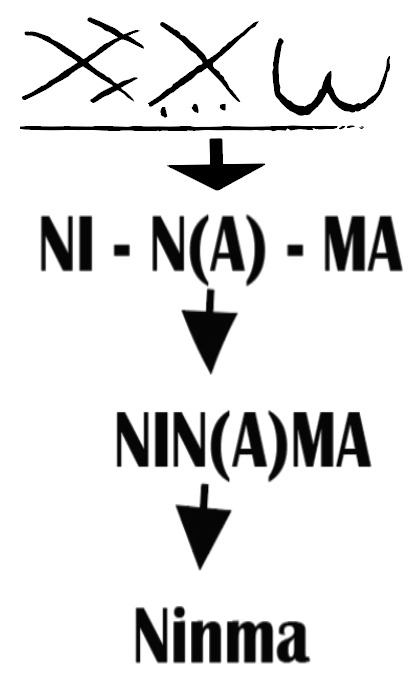
Sentence Structure
The Kishic language primarily follows a subject-object-verb structure.
Nar(u)l Nina(a)ma hara(a)ziga(a)s.
Narul Ninma harazigas.
Narul Ninma carried.
Narul carried Ninma.
Noun and Adjective Declensions
The Kishic language system consists of the following cases: nominative, genitive, dative/accusative, and possessive (the Shabalic language includes an instrumental case), and distinguishes between two numbers (singular and plural) and two genders, Masc (masc/neutral/inanimate) and Feminine.
A few examples of the scheme of suffixation are given in the tables below.
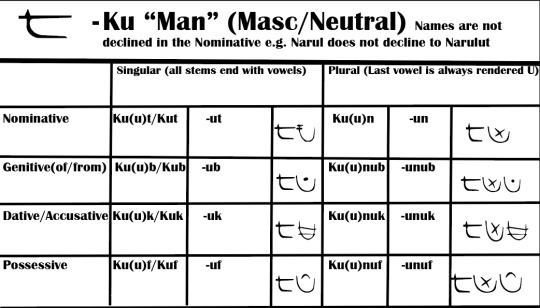

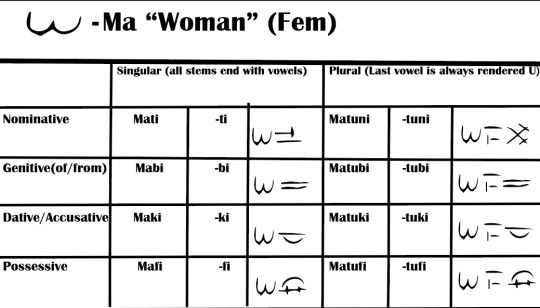
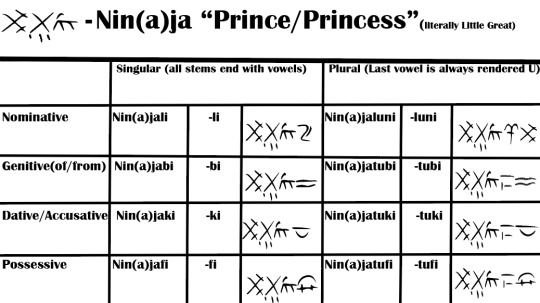
Sample Verb Stems
Verb stems always end with -i.
Talk: Akki
Breathe: Ki
Eat: Ushki
Struggle: Nari
Sleep: Eshsi
Fight: Orishri
Hunt: Pabakazi (Literally Bow art(ing))
Dance: Irteti
Kiss: Mishuzi
Copulate (and the more vulgar equivalent): Seshiti/Tu(u)ki
Verbal Conjugation
There are two general verbal classes according to which verbs are inflected, the aha-conjugation and the awa-conjugation. Within the Kishic language there are two voices (active and medio-passive), three moods (indicative, subjunctive, and imperative), two aspects (perfective and imperfective), and nine tenses (Simple Past, Perfect Past, Continuous Past, Simple Present, Perfect Present, Continuous Present, Simple Future, Perfect Future, Continuous Future).
The present tense can be identified by -i/-a/-u, past by -as, and future by -ad.

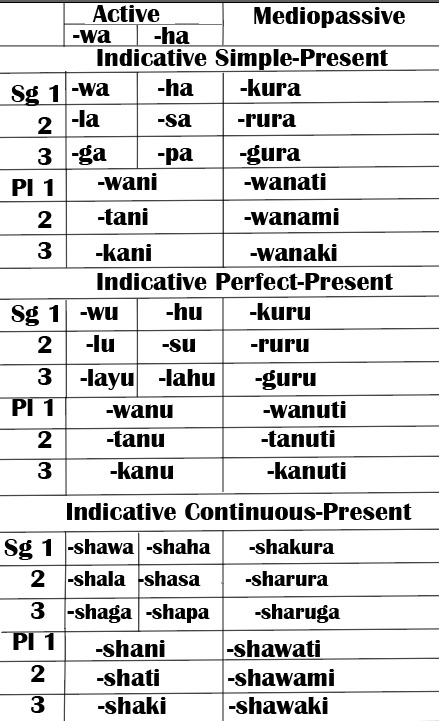

Additionally, the verbal system displays infinitives and participles in the present and past tenses.

Prounouns


Articles

Sample Sentence

#writeblr#worldbuilding#fantasy#writing#wip#queer fantasy#fantasy world#conscript#fantasy language#fantasy writing#world building#testamentsofthegreensea#conlang#kobaniquestions
19 notes
·
View notes
Text
Creating Your Fictional Language AKA Conlang
Hi Everyone!
As I am working currently on a conlang for my WIP, I thought I might post about the steps for anyone else thinking of going above and beyond in their world building to create an entirely new language.
First: if you don’t want to create your own language but need one for your WIP, there are many online generators that will do it for you. My favourite is vulgarlang.com and it comes with a free demo version.
Before we begin:
IPA: learn all about the International Phonetic Alphabet. This is when you will be deciding which sounds will be present in your language.
Study existing languages to get an idea of all the ways you can design your alphabet and language. This will give you an idea for grammar, punctuation, sentence structure etc.
Getting Started:
Name your language.
Make your alphabet. This can mean creating your own drawings for sound, or using an alphabet that already exists. You can make an alphabet, each symbol representing a particular sound (up to about 50 usually) , a syllabary which represents a syllable (up to about 100) or pictographs (hundreds needed).
Create words by putting your sounds together. Try combining words to make new but similar words. For example, any is an indeterminate word, and where is for a place, anywhere being a compound word being a place that does not have a pre-determined location.
Order your sentences. English has an order of subject-verb-object (the dog ran after the ball), while in Japanese they use subject-object-verb. Once you choose an order for where your words fit into your sentence, be sure to always follow the pattern as to not be confusing later on.
Make grammar rules. These are the rules that dictate your language, and if you are following the steps, you will have already started. Does your language have plurals? How many ways can your verbs be conjugated? Is your punctuation the same as in English?
Start creating your dictionary, and be sure to always write it down and keep notes, or you won’t remember.
Practice. Practice. Practice. Create new documents using your language, writing journals entries, translating books or try speaking it out loud. Get to know your language.
For languages similar to English, here are the word classes to help you start choosing which words you need translated: nouns, verbs, adjectives, adverbs, prepositions, pronouns, determiners/articles, interjections and suffixes. Please note, not all languages have these classes, and your language may not require them either.
Things to remember:
Making a symbol equal to English letters and writing English words with your new alphabet is a cypher, not a new language.
The shape of your creature’s mouth will determine the sounds they can make. That being said, if you make a language too hard to pronounce or remember, no one will be able to learn it. You probably want your new language to be useable.
Homophones are words that sound or are written the same, but have different meanings. This happens all the time, just be careful when using similar words, people will confuse them often. This could mean your character learning the language can make people laugh with silly comical mistakes, or insult an entire race.
Your conlang will, and should, have words that don’t translate to English, and that’s ok. A fantasy world will likely have many different words that we are not accustomed to for things like weapons, or food or instruments we don’t have.
Implementing the language into your WIP is an art. You want the language to come naturally to native speakers, but using too many words too quickly will draw attention away from your words, and your reader will start to skip them. Try putting in a dictionary at the start of the book for reference, and slowly growing your readers knowledge without overwhelming them. No one wants to try to remember a new language while also getting to know your characters, environment and plot.
Keep in mind, all languages have slang and idioms. There may even be several dialects of the language, similar to English. Don’t forget, you also need a new name for their currency. These are all things you need to consider when creating your language.
You need about 800 to have conversational basics and over 8000 words to be a native speaker of a language. No matter where you end up, you need to start somewhere.
Hopefully this is helpful to someone! If something I wrote is wrong, please let me know so I can change it :) Any questions, comments or concerns, message me or leave them below!
Happy Writing
#creative writing#language resources#conlang#fantasy language#wip stuff#writing a language#writeblr#writer#novel writing#writing advice#writing community#tumblr writers#writing#writerscommunity#story writing#writer tips#write write write#write what you want#fiction#female writers
176 notes
·
View notes
Text

[PONEGLYPH FANLANG] Chapter 272's Stelle transcription and translation
Hello, back with the Poneglyph Fanlang!
After previously translating Roger's words on the Shandora Grand Bell, as seen here: [WIP] One Piece's Ancient Language (Poneglyph) Fanlang, I'm now attempting to translate another Poneglyph with a full translation. In the canon manga, only two Poneglyphs have full translations. This one is from Chapter 272, "Play," and was discovered by Robin.
If you're familiar with the Japanese language, you might notice that the sentence structure is identical to Japanese syntax (SOV). The basic language used is Old Egyptian, employing a triconsonantal root system similar to Arabic.
Here are some words you might recognize if you know Japanese:
okkaret = kokoro (heart)
enṓganopet = ogane (big bell)
You may notice that the same sound can be represented by completely different glyphs. This is because the Poneglyph uses a system somewhat akin to the Maya script and Rongorongo script, allowing different glyphs for the same sound for aesthetic reasons. Another reason for these complex sound-to-glyph correspondences is to make Poneglyphs difficult to read and decipher by the government.
But let me be honest, the main reason is that the Poneglyph is a gibberish-type of conlang. It seems like Oda didn't create a fully functional conlang for Poneglyph and may have scribbled-down the script. Or perhaps Oda used a cipher conlang? Who knows.
#poneglyph#one piece#onepiece#conlang#constructed language#worldbuilding#fantasy language#nico robin#budkalon#linguistic#OP#fan conlang#fanlang
49 notes
·
View notes
Note
Happy WBW! [sorry for getting to this so late in the day ('o.o)]
What can you tell me about the writing systems of the world?
EEE CONLANGING! So writing originated in my world from recording how you draw spells. Most places used a pseudo-logography except in the last 3 generations here: Due to industrialization and war, governments have simplified a lot of languages so the average person can access them easier!
You probably want to see them now... so here they are :DDDDD
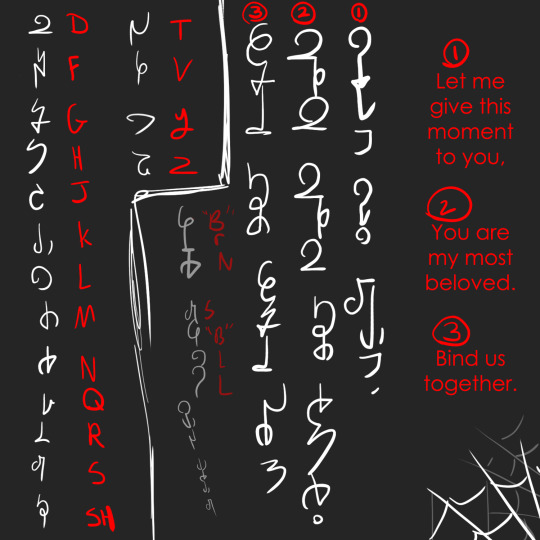
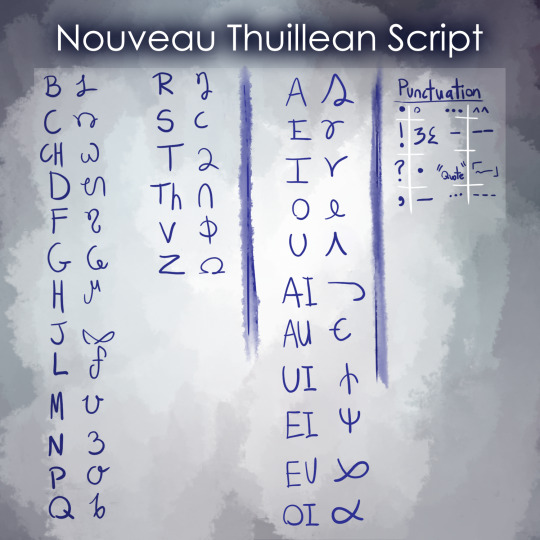




Sealtongue doesn't have its own writing system -- but it COULD. Cuz it's a Tokiponita so it only has like 120-something words... maybe it could have a logography easier...
Anyway, that's the tl;dr of my writing systems!
#conlang#worldbuilding#neography#conlang script#fantasy language#clong#writeblr#amai answers#amaiguri#yssaia
11 notes
·
View notes
Text
I feel like most fantasy media has demons and devils and various other similar entities are depicted exclusively as evil things that you can't even make alliances with because they're going to screw you over no matter what.
Well, why not do something different to what's standard.
I've already talked about how maybe the word demon itself could have different meanings and connotations depending on the language and culture of the person saying it, so hey maybe some demons could just be entirely normal people just living in the underworld who don't even have any devilish powers.
Maybe some demons who do have powers could grant their powers primarily as a way of getting to experience the locations outside of the underworld while minimising the risks that truly leaving could entail.
Some could even be taken advantage of due to desperately wanting to see the world above.
You could also just have a location whose culture just sees making deals with demons for power as a standard part of life.
Additionally, if this location was surrounded by others that regard demons with the typical destain seen in fantasy they'd probably end up being quite isolated in terms of trade and culture, which might then lead to the people there seeking even more power from demons so they can be self-sufficient.
#fantasy ideas#fantasy setting#fantasy locations#fantasy culture#fantasy politics#fantasy language#technically i guess#world building
78 notes
·
View notes
Text
Anyone know how Duolingo chooses what constructed languages to teach and how we can petition them to teach Grishaverse languages?
Asking for a friend
#grishaverse#duolingo#six of crows#crooked kingdom#leigh bardugo#inej ghafa#kaz brekker#jesper fahey#nina zenik#matthias helvar#wylan van eck#kanej#Wesper#helnik#six of crows duology#constructed language#fantasy language#learning languages#languages#queued
276 notes
·
View notes
Text

User CyberWitch from our discord made this lovely quiz to figure out just where in the Grishaverse you'd hail from! With the lovely support of our conlangers and the languages the Grishaverse has to offer, it's neat to discover where we all fit in our favorite world!
Take the quiz for yourself today!
#grishaverse#shadow and bone#six of crows#netflix#netflix shadow and bone#soc and ck#sab#kazzle dazzle#six of crows fandom#soc#conlang#fantasy language#langblr#save the grishaverse#grishaverse fandom#the grisha series#ravka#ketterdam#shu han#fjerda#novyi zem#leigh bargudo#no mourners no funerals#six of crows spin off#six of crows spinoff#saveshadowandbone#save shadow and bone#fantasy geography
42 notes
·
View notes
Text
PANDORIAN LANGUAGE III.
-> SSO unofficial / fanmade conlang project
-> Grammar, pronouns, adjectives, verbs, nouns and example sentences, useable language
-> See my posts Pandorian Language I. and II. for more info

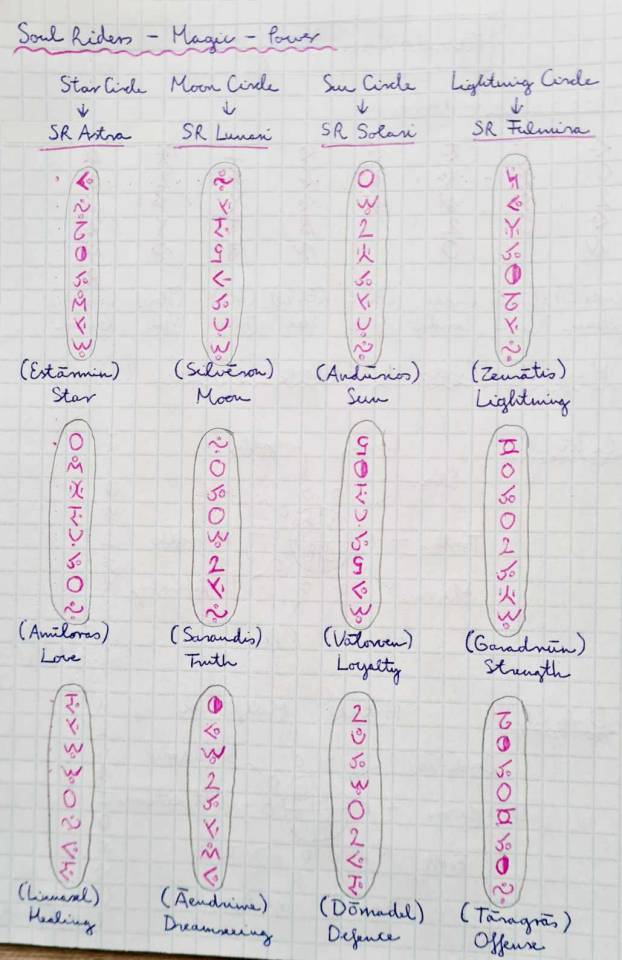




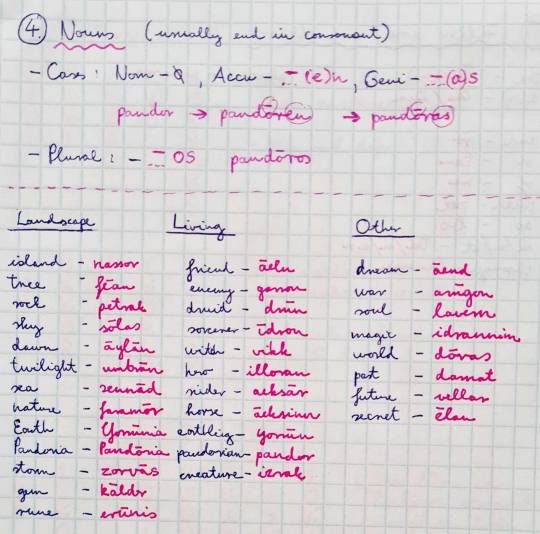
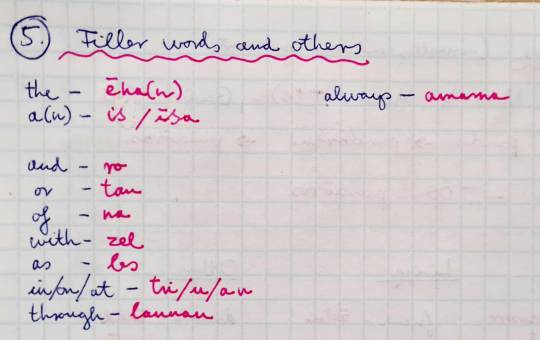
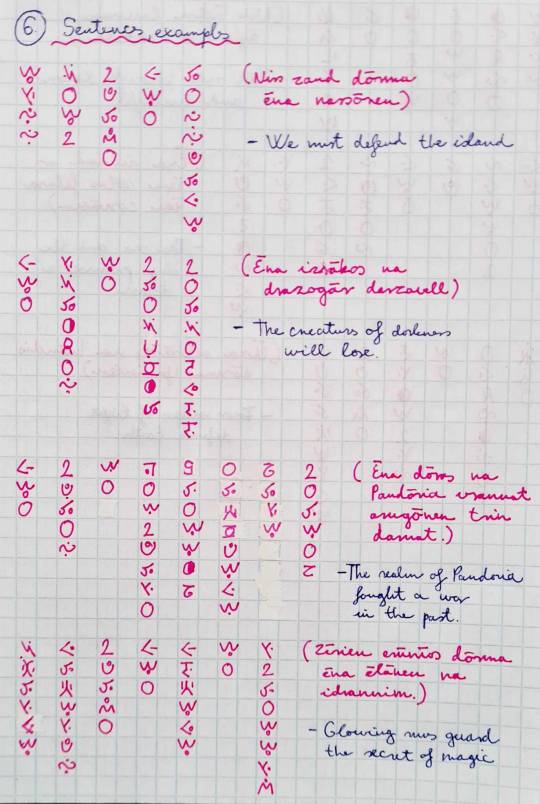

Alphabet:

#sso#star stable#star stable online#ssoblr#sso magic#sso rewritten#sso pandoria#fantasy language#conlang#sso runes#sso runestone
62 notes
·
View notes
Text

I didn't run my campaign this weekend because people were busy, so instead I made up an alphabet for the ancient culture of Kessar!
The sounds common to this language don't really match up well with the English alphabet, so instead i used the international phonetic alphabet, which. Definitely makes it harder for the layman to use, but I feel like that's kind of in keeping with the culture it's from lol.
Each circle is denoted by a specific kind of line, with the direction of said line denoting the specific letter. To write words, people start out at the center of the circle and move outwards, with the next letter landing at the radial point that the previous one started with.

While the circle grid is regularly used by those in the process of learning to write, it eventually becomes phased out as students gain proficiency, leaving the end product looking like this.

Some additional fun facts about the language!
Though the 'd' sound is notated in the translation chart, and 't' isn't, the language actually registers no difference between the two, and pronounces them sort of in between voiced and voiceless
Kessarum culture considers it vulgar to under-pronounce, or slur vowels, so outside the diphthongs present in the fourth circle, any combined vowels would be expected to make two separate sounds (these homies would riot if they heard about schwa lol)
In Kessarum culture, names are expected to look aesthetically pleasing as much as they are to sound good
the number 8 is very important to Kessar, which is why each circle has 8 letters in it, and why there's 32 letters total
generally speaking, the first order consonants are more common within the language than the second order consonants
#world building#fantasy language#demesne principalia#that's gonna be the tag for all my d&d world building stuff lol#i've been meaning to start posting it on here for a while now. there is So Much Lore
3 notes
·
View notes
Text
When you make your own fantasy conlang trying to run away from Fr*nch only to realize that your number system is horribly similar to the Fr*nch number system and so you just have to start internally sobbing because your almost 4 years deep into this and it's too late to change it now because you actually semi-structered your fantasy language's fictional basis around the number system because you somehow live to torture yourself.
#fantasy language#conlang#writing#fantasy#that moment when you realize youre not NEARLY as invested in the story you started writing as you are in the LANGUAGE you created for it#linguistics#make my brain happy while simultaneously making me want to rip my brain out
2 notes
·
View notes